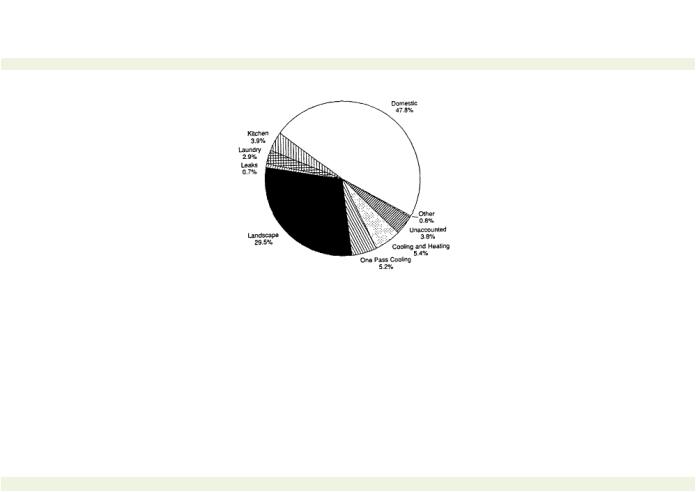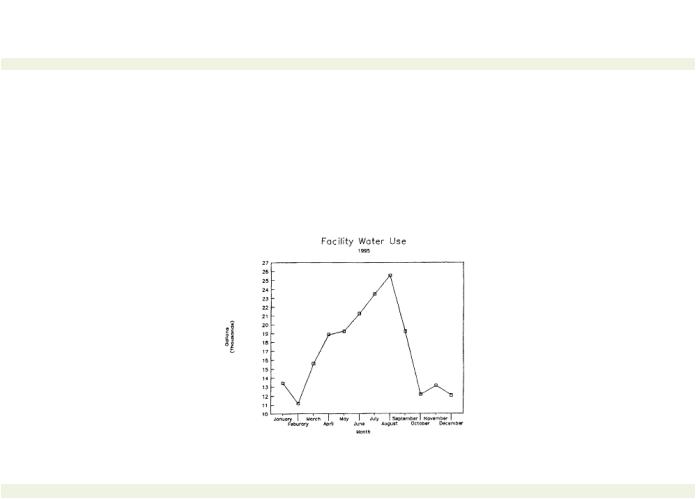
water quality and system
.pdf
< previous page |
page_xxiv |
next page > |
Page xxiv
Water Purity
A complete chapter on water purity is provided that discusses, among other things, various forms of impurities and the treatment methods for removing them. A table of health hazards and regulatory standards is provided to indicate to the facility manager what the requirements are. The chapter tells a facility manager how to hire a laboratory, how to have water quality tests conducted and how to interpret the lab's results.
Construction
Methods of construction, along with the tradeoffs, will be shown. Sources of pricing for labor and materials and computation of quantities will be provided. Forms and formats are included to make the manager's duties simpler and more effective.
Finally, the text will go into the testing that accompanies any major system modification or retrofit. The testing will be based upon accepted industry standards.
Appendices at the end of the text will furnish guides to industry associations and manufacturers.
Throughout Water Quality & Systems are many cost-saving, money-saving ideas or tips that will make it well worth reading. The first step water supply, or getting water where you need it when you need it begins in Chapter 1.
< previous page |
page_xxiv |
next page > |

< previous page |
page_1 |
next page > |
Page 1
Chapter 1
Water Use and Abuse
Planned water management can be a challenging task for facility managers. It requires managing the water supplies and wastewaters into and out of his facility, and recognizing the significant costs and risks. An understanding of the basic elements of successful water management is an essential building block to ensuring that the proper quantity and quality of water is available every day to occupants and visitors.
Planned Water Management
Just last week, the local press reported sewage had been discovered in the drinking water system of the little town across the valley. The city officials were sterilizing the system but citizens had been advised not to drink the water and to sterilize it by boiling it before using it.
No water manager or professional wants this to happen. It reflects upon the care and trust of people who rely on water for life. Successful water managers make sure their water is clean. Codes, standards and laws are written to make sure it stays clean. Water should be available in ample quantity and at the right pressure for everyone, because everyone needs it.
In addition, waste water, because of its potential hazards to health, should be carried safely to a point where it can be successfully treated and its pollutants safely and efficiently removed.
Within these broad goals, a successful water manager attempts to keep the costs of maintaining water quality, distribution and waste
< previous page |
page_1 |
next page > |

< previous page |
page_2 |
next page > |
Page 2
under control. Water and wastewater costs are heavily subsidized with tax dollars but as tax dollars dwindle, the burden of paying for water and water system management falls upon the facility.
Water In, Water Out
Unless the facility has taken upon itself the role of drinking water treatment, the water supply is assumed to be fit for drinking when it enters the facility. Most plants have a ready source of treated water, but after the water crosses the boundary into the facility the responsibility for maintaining the water's quality is the facility manager's.
A few communities in America use untreated supplies from deep wells. In many cases, the water is filtered and treated to remove disease-carrying microorganisms.
Once the water has been used, wastewater flows into a centralized collection system where it is conveyed to a treatment plant for removal of the pollutants. The treated water is then discharged into a lake, stream, canal or other body of water.
Water, therefore, is not actually consumedit is simply changed from drinking water to sewer water as it passes through the facility.
Water Supplies
Most people do not worry about their water supply. Worry is the job of city officials. But local governments know where their water comes from and have projections about the amounts they have or will have available from year to year. Today, water use is changing and efforts are underway to reduce consumption wherever and whenever possible.
Water Costs
Water managers find their water is inexpensive. In fact, it is so inexpensive that most managers do not really worry about their budget when it comes to water costs. It is usually the costs of water treatment that surprise them. The fact is, a lot of tax dollars have already gone into the water supply. Most of the utility coststhe treatment plant, the water mains, the staff to do the treatment, chemical analysis, etc.have already been taken care of by the tax-funded utility. The facility manager can rely upon good quality water but he pays for it every month, some paid for in the property tax, the balance paid for in the form of a water bill.
< previous page |
page_2 |
next page > |

< previous page |
page_3 |
next page > |
Page 3
Figure 1-1.
Typical water use. Courtesy: The Denver Board of Water
Commissioners, Non-Residential Water Audit, Summary Report 1991.
Quantity
Individual Uses
Facility managers make use of water the same way residences doin fact, most facility use is fairly parallel to home use. Water is used for washing, bathing, sanitary waste, cooking and drinking. In addition, facility managers use water for make-up of evaporation in pools, for cooling, in air conditioning, for lawns, gardening or grounds keeping. Managers also use water in industrial processes unique to their facility (see Figure 1-1).
Light Industrial and Manufacturing Uses
Industrial and manufacturing facilities use water for cooling, washing, carrying away waste, and mixing.
For individuals at these facilities, water requirements are going to be between 70 and 120 gallons per person per day. About 70 gallons per person per day is used for washing/bathing and for the toilet. In an office environment, with cooking and bathing left at home, water for personal use will be lower than these figures.
< previous page |
page_3 |
next page > |

< previous page |
page_4 |
next page > |
Page 4
Lawns and Agricultural Use
The other parameters, for lawns and grounds-keeping, vary with seasons, and with size of the complex. Lawns of grasses will require approximately eight/tenths of a gallon per day per square yard (3,500 gallons per acre) and are also dependent upon recent weather conditions.
For agricultural use, water usage depends upon season and the crop. Many sophisticated techniques are used to estimate plant demands for agriculture. For lawns, the most effective application is to use water sprinklers. For agriculture, sprinklers are also very effective but the sprinkler systems are quite expensive, and for this reason crops are often flood-irrigated. Flood irrigation is not a relatively effective use of water since much of the water is consumed by evaporating from the soil before it reaches the plants. In desert environments, a new method of water conservation, called drip irrigation, is used to apply water directly to the plant. Drip irrigation is approximately the same cost as using sprinklers.
Industrial Uses
Determining the needs for industrial processes is more complex, although engineers have become adept at estimating needs for several types of use. Where water is needed for cooling, engineers can figure out how much water is needed from knowing how much heat is generated or fuel is being burned. The heat is a result of the process calculations (for a short discussion of heat, see Chapter 6, hot water systems). Water use for mixing is computed by engineers in a similar way.
One major factor in calculating the sizes of the pipes for any facility is the need to provide water for fire-fighting. As a result, pipes are sized greater than needed to put out a fire.
Delivery
In addition to knowing the amounts to be delivered, the problem of delivering at the correct pressure is also encountered. While a few systems have natural pressure, most water supplies are pumped. Facilities can receive supply at a central metering station or at a series of stations located around the perimeter. Water must have enough pressure to reach the point of delivery and must flow from the point of delivery in sufficient quantity to meet the demand.
For tall buildings or facilities located on a hill, the water is
< previous page |
page_4 |
next page > |

< previous page |
page_5 |
next page > |
Page 5
pressurized through the use of pumps and occasional storage in the upper stories of the buildings or water towers. Pumping to storage tanks allows use of smaller pumps. However, the facility must pay additional for the costs of the tanks for storage. (For a discussion of the tradeoffs between constant pumping and storage, see Chapter 3, where we discuss pipe hydraulics.)
Pollution/Washing/Waste
Management of wastewater from washing and carrying away wastes are different from the management of fresh water supplies. As with fresh water, pipes are used to carry the flows and the waste-waters are derived from the incoming supplies. But wastewater management deals with essentially contaminated or polluted water, and hence the procedures and management principles are slightly different.
One overriding principal rule applied by environmental regulators is: "Dilution is not the solution to pollution."
A simple statement perhaps, but this statement, which reflects some strict environmental rules relative to hazardous waste and to a lesser extent to other types of wastes, means that washing away a spill or cleanup from processing operations is not generally allowed. The facility manager is required to clean up the water before letting it go back into the environment.
A case study is included at the end of this chapter. (For a discussion of the most significant environmental regulations faced by today's facility managers, see Chapter 7. For a complete discussion of wastewater management, see Chapter 9.)
Utility Billings
Depending upon who the facility manager pays for water, the utility usually reads the meter and bills the user monthly. Past evaluation of utility billings is an excellent method of determining the quantity of water used throughout the year. Some utilities have started quarterly billings to save staff costs of reading meters and preparing the paperwork that goes along with the bills.
By evaluating the facility utility bills, the facility manager can determine trends in water use over the year. Facility mangers familiar with use of Personal Computers can use a database or spreadsheet program to plot uses over time from the billings (see Table
< previous page |
page_5 |
next page > |

< previous page |
page_6 |
next page > |
Page 6
1-1 and the accompanying Figure 1-2 to see how past utility billings can aid in an assessment of quantity uses and demands).
Where in the United States or Canada the facility is located will determine the amount of information the facility manager can obtain from his monthly or quarterly billings. In some areas, the sewer billing is a function of the water supply which is done to eliminate costly metering of the sewage flows. In other areas, sewer billing is a fiat fee depending upon the size of the complex or number of people working there. Some large facilities have their own water supply and sewage treatment systems.
These large self-contained facilities will be discussed in later chapters, but facility managers with their own systems should have metering and utility data in a similar manner to any utility. By metering and keeping records, the facility manager can report to higher management the value of the services being provided. This type of information is necessary because of the tendency to consider contracting out support services by many organizations.
Some terms used by engineers and utilities for measuring water use for large users include, cubic meters, cubic feet, gallons, and acre feet (see Table 1-2 for a list of conversion factors to convert quantity figures between units).
Table 1-1. Table and plot of water use from utility bills (see Figure 1-1).
Month |
Use In Gallons |
January |
13,000 |
February |
12,000 |
March |
18,000 |
April |
22,000 |
May |
25,000 |
June |
28,000 |
July |
33,000 |
August |
30,000 |
September |
26,000 |
October |
21,000 |
November |
17,000 |
December |
14,000 |
< previous page page_6 next page >

< previous page |
page_7 |
next page > |
Page 7
Metering
Metering the supply is usually the responsibility of the utility. Meters are typically located at the property boundary, and large users' meters are installed either underground in a vault or on the main water pipeline where it enters the building. Flow measurement meters work on the basis of one or two theoretical principles. These theories have been checked time after time and have been essentially proven by the industry (see Chapter 4 for further discussion on meters).
In addition to metering the volume, the utility will sometimes provide a temporary meter that continuously monitors the flow throughout the day for several days. This type of service is potentially free since both the utility and the facility manager benefit from the results of the information. The result of this type service allows the facility manager to plot his or her peak flows and enables him to locate major users.
In a large facility, multiple users of large amounts of water can sometimes lead to unexpected problems. One facility found that when the laundry was operating and the lawn sprinklers were fully on, water pressure was so low in the high rise building on the
Figure 1-2.
Facility water use 1995 (see Table 1-1).
< previous page |
page_7 |
next page > |

< previous page |
page_8 |
next page > |
Page 8
campus that the water coolers did not have enough pressure to allow students to get a drink. Spot pressurization, using pumps, was necessary to keep the pressure up in one area while use was curtailed in other areas. By measuring flows and pressures, the facility was able to isolate this root problem.
Water Treatment
The most common method of water supply treatment in the United States is the use of alum to settle out the solids and clarify the water. A utility filters the water, adds the alum and allows it to settle out, then injects chlorine to make sure the water is free of bacteria. (New trends in water treatment using ozone and other more sophisticated disinfectants are explained thoroughly in Chapter 10.)
Once the water enters the property, however, the facility manager is responsible for it.
A few facilities have their own supply. In these cases, the facility takes responsibility for performing its own treatment. Most public supplies come from rivers or lakes, while some comes from springs. Smaller communities get their supplies from wells where less treatment is required. In general, well water is often hard and needs to be softened. (Wells for water supplies are discussed in Chapter 2. Water softening is a subject covered Chapter 8.)
Wastewater Treatment
Waste water is often required to be treated and facility managers who have added lots of chemicals in washing or used the water for cooling or blanching are required by regulations to treat the water before it leaves the property. Such methods could include settlement as in a pond or tank and/or retention while micro-organisms remove organic material. (Other methods including filtering, aeration, percolation and digestion are discussed in Chapter 9.)
Common Complaints
Many first-time water managers find that water costs are such a low end of their budget they do not have to worry about cost when they take over their role as a facility manager. Energy (fuel) costs and electric power are first and second respectively in dollar value. But when there are water or wastewater system problemsthe supply is too low, the water is off or seems cloudy, or the wastewater is
< previous page |
page_8 |
next page > |

< previous page |
page_9 |
next page > |
Page 9
contaminated with a pesticidethen the devil is due. Nobody cares how much it costs and nobody cares whether the facility manager saved any money in the account when the quality/of the water has been questioned.
Common complaints include, ''Gee the pressure is low." "Gee, the water tastes salty." "Gee, the water is cloudy... rusty ... warm?" This and a host of other problems must be solved by the facility manger (see Table 1-3 for a list of common complaints and probable sources). One of the best things a manager can do is find out where the problem is and get a trained staff person there as quickly as possible to check the water and answer the complaint. In addition, water managers have come under fire recently for contaminated/or tainted supplies that, while they do not affect a healthy user, may potentially affect occupants who are immune-deficient in some way. This could include a person who has been diagnosed with HIV syndrome or someone with cancer, pneumonia or AIDS. These people, who would not normally be affected by minor amounts of impurities in the water supply, are likely to sue the facility that gave them impure water that exacerbates their illness.
Unspecified complaints should be verified with lab tests. Sometimes the source of the problem will be immediately apparent, but sometimes it disappears mysteriously. Too many complaints of water problems that are not isolated and solved by the facility manager will lead to problems for that manager in short order.
The only way a facility can adequately determine whether or not there is a water problem by taking a sample of the water and having it analyzed in a laboratory (see Chapter 8).
Laboratory Tests
Most facilities will want to have a working relationship with a
< previous page |
page_9 |
next page > |
